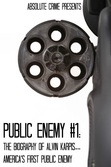Public Enemy #1: The Biography of Alvin Karpis--America's First Public Enemy

Before John Dillinger, Pretty Boy Floyd, and Baby Face Nelson made the term "Public Enemy" famous, there was Alvin Karpis--one of the ruthless leaders of the Barker-Karpis gang. It was him that J. Edgar Hoover first thought worthy of the title Public Enemy
In a page-turning style, this true crime book traces his criminal orgins from his young days as a bootlegger to his ultimate demise.
In a page-turning style, this true crime book traces his criminal orgins from his young days as a bootlegger to his ultimate demise.
Buy Now!
Public Enemy #1 PDF and ePub |
Excerpt
Chapter 1: The Kidnapping of William Hamm Jr.
The second week of June of 1933 was a disaster for the US Bureau of Investigation. It would take three years for the crime-fighting arm of the Department of Justice, later renamed the Federal Bureau of Investigation, to regain public confidence. It took even longer for its agents to appear to live up to the Bureau’s motto of “Fidelity, Bravery and Integrity.”
In 1933, the Bureau’s agents were disorganized, followed sloppy investigative procedures and regularly let cornered suspects slip through their dragnets. They were accused of corruption, some of them working hand in glove with felons and others using unscrupulous practices to obtain convictions. In this they were no different from local police in many jurisdictions. The loyalty of the Bureau’s agents was to change slowly as the young director, John Edgar Hoover, turned setbacks to his advantage. He hit on the peculiar idea that he could ensure some measure of ethical behavior if he hired only lawyers and accountants. Of most importance to improving the Bureau was his successful lobbying the government to obtain for his the agents the right to make arrests and carry firearms.
The first calamity began with the bold, daylight abduction of William Hamm Jr. right in front of his Swede Hollow brewery in the Phalen Creek Valley of St. Paul, Minnesota. The idea for the kidnapping was the brainchild of an unsavory local named Jack Peifer. For a small cut of the takings, he put his idea to a notorious gang of bank robbers.
William Hamm Jr., the grandson of Theodore Hamm who founded the brewery in 1865, strolled out of his office on June 15 and headed off to his nearby mansion for lunch. He was approached by a grey-haired man who looked to be in his 60’s. Well dressed in a conservative, expensively tailored business suit and wearing a stylish black homburg, Chuck Fitzgerald smiled as he thrust out his hand to the wealthy businessman.
“I wonder if I might have a word with you on a business matter,” he said, shaking Hamm’s hand firmly.
Without releasing his grip, Firzgerald gently escorted Hamm to a shiny limousine with a uniformed chauffer standing by the driver’s door. Hamm was gently pushed into the back seat and Fitzgerald followed him in. The chauffer climbed behind the wheel and two men loitering nearby ran to the vehicle and jumped in, one in the front seat and the other beside Hamm in the back.
Fitzgerald politely said to his guest, “I don’t like to do this but I’m going to have to ask you to get down on the floor. I hope you don’t mind but I don’t want you to see where you are going.”
The chauffer, who was watching in the rear-view mirror as he started the limousine, later reported that Hamm looked puzzled. Nevertheless he agreed to the request and kneeled down on the floor. After a short drive the limo stopped next to another car. Two men got out and handed four identical ransom notes to Hamm, who silently read them and without objection signed his name to each.
Blindfolded with cotton balls held against his eyes by a pair of sunglasses, Hamm was silent during the 385 mile drive from St. Paul to Bensenville, Illinois. The limo driver, disguised as a chauffeur, was Alvin Karpis. He was highly respected in the underworld as a thoroughly professional bank robber. Beside him on the front seat was Arthur R. Barker (known as Doc), the ex-con and bank robber son of Arizona Barker. On one side of Hamm in the back sat Monty Bolton, a gunman who worked for the Chicago Syndicate who had participated in the St. Valentine’s Day Massacre of 1929 in which seven mobsters were “rubbed out” on the orders of Al Capone. On the other side of Hamm was Chuck Fitzgerald, the eldest member of the Barker-Karpis Gang. The two men who had handed the ransom notes to Hamm were Doc Barker’s brother Fred and George Ziegler, also a veteran assassin in Al Capone’s Chicago mob.
In Bensenville the kidnappers and their victim holed up, as previously arranged, in the Postmaster’s house. Karpis alone tended to Hamm, who was held in an upstairs bedroom while Ziegler and Fred Barker worked on the delivery of the $100,000 ransom. Karpis described Hamm as an “okay guy” who was no trouble. What upset the peace in the house was news of a massacre in Kansas City. This was the second disaster for the Bureau of Investigation that week in June.
The second week of June of 1933 was a disaster for the US Bureau of Investigation. It would take three years for the crime-fighting arm of the Department of Justice, later renamed the Federal Bureau of Investigation, to regain public confidence. It took even longer for its agents to appear to live up to the Bureau’s motto of “Fidelity, Bravery and Integrity.”
In 1933, the Bureau’s agents were disorganized, followed sloppy investigative procedures and regularly let cornered suspects slip through their dragnets. They were accused of corruption, some of them working hand in glove with felons and others using unscrupulous practices to obtain convictions. In this they were no different from local police in many jurisdictions. The loyalty of the Bureau’s agents was to change slowly as the young director, John Edgar Hoover, turned setbacks to his advantage. He hit on the peculiar idea that he could ensure some measure of ethical behavior if he hired only lawyers and accountants. Of most importance to improving the Bureau was his successful lobbying the government to obtain for his the agents the right to make arrests and carry firearms.
The first calamity began with the bold, daylight abduction of William Hamm Jr. right in front of his Swede Hollow brewery in the Phalen Creek Valley of St. Paul, Minnesota. The idea for the kidnapping was the brainchild of an unsavory local named Jack Peifer. For a small cut of the takings, he put his idea to a notorious gang of bank robbers.
William Hamm Jr., the grandson of Theodore Hamm who founded the brewery in 1865, strolled out of his office on June 15 and headed off to his nearby mansion for lunch. He was approached by a grey-haired man who looked to be in his 60’s. Well dressed in a conservative, expensively tailored business suit and wearing a stylish black homburg, Chuck Fitzgerald smiled as he thrust out his hand to the wealthy businessman.
“I wonder if I might have a word with you on a business matter,” he said, shaking Hamm’s hand firmly.
Without releasing his grip, Firzgerald gently escorted Hamm to a shiny limousine with a uniformed chauffer standing by the driver’s door. Hamm was gently pushed into the back seat and Fitzgerald followed him in. The chauffer climbed behind the wheel and two men loitering nearby ran to the vehicle and jumped in, one in the front seat and the other beside Hamm in the back.
Fitzgerald politely said to his guest, “I don’t like to do this but I’m going to have to ask you to get down on the floor. I hope you don’t mind but I don’t want you to see where you are going.”
The chauffer, who was watching in the rear-view mirror as he started the limousine, later reported that Hamm looked puzzled. Nevertheless he agreed to the request and kneeled down on the floor. After a short drive the limo stopped next to another car. Two men got out and handed four identical ransom notes to Hamm, who silently read them and without objection signed his name to each.
Blindfolded with cotton balls held against his eyes by a pair of sunglasses, Hamm was silent during the 385 mile drive from St. Paul to Bensenville, Illinois. The limo driver, disguised as a chauffeur, was Alvin Karpis. He was highly respected in the underworld as a thoroughly professional bank robber. Beside him on the front seat was Arthur R. Barker (known as Doc), the ex-con and bank robber son of Arizona Barker. On one side of Hamm in the back sat Monty Bolton, a gunman who worked for the Chicago Syndicate who had participated in the St. Valentine’s Day Massacre of 1929 in which seven mobsters were “rubbed out” on the orders of Al Capone. On the other side of Hamm was Chuck Fitzgerald, the eldest member of the Barker-Karpis Gang. The two men who had handed the ransom notes to Hamm were Doc Barker’s brother Fred and George Ziegler, also a veteran assassin in Al Capone’s Chicago mob.
In Bensenville the kidnappers and their victim holed up, as previously arranged, in the Postmaster’s house. Karpis alone tended to Hamm, who was held in an upstairs bedroom while Ziegler and Fred Barker worked on the delivery of the $100,000 ransom. Karpis described Hamm as an “okay guy” who was no trouble. What upset the peace in the house was news of a massacre in Kansas City. This was the second disaster for the Bureau of Investigation that week in June.








